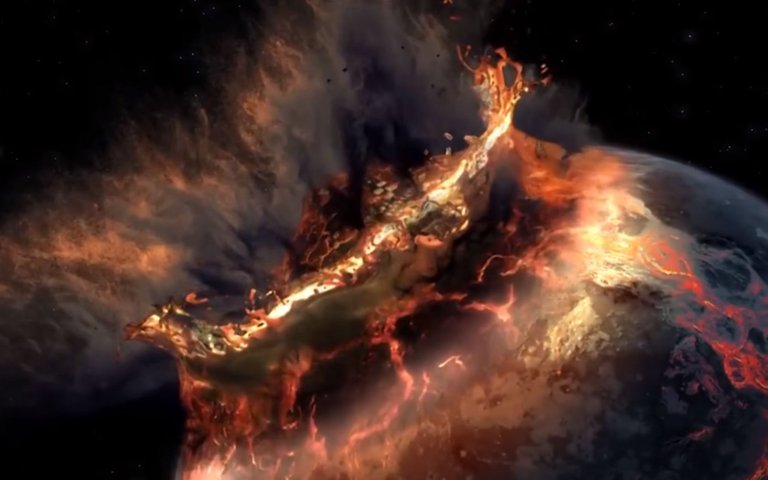What If A Meteor Hits The Earth At The Speed Of Light?

More than four billion space bodies, a.k.a., meteoroids fall into the Earth's gravity well every day. This moniker covers everything in size greater than interplanetary dust, but less than that of an asteroid. These are small stones in the majority which quickly burn up in the terrestrial atmosphere. Only a few can pass this barrier. Meteoroids that reach the Earth's surface are then called meteorites. At the same time they do not pose a particular danger. Although occasionally they can make local residents nervous, as happened recently in Chelyabinsk (2013 in Russia).
But what if we increase the velocity of the meteorite to the speed of light?

No particle with mass is actually capable of the speed of light, but in fact, for our purposes we don't need it. It will be enough simply to "approach the speed" just a little such that the entire solar system will be in shock. But let's do this in the proper order:
Imagine that we have a round diamond ball 30 meters in diameter, and we have just launched it in the direction of the Earth at a speed of 3,000 kilometers a second. First of all it should be noted that the air in our atmosphere begins to participate in Nuclear Fusion at such velocities. And with this plasma heating, the process might be able to destroy our diamond sphere entirely before it reach the Earth's surface. But the Earth will not get the better of us. This sphere will not fly wide enough and at some point will crash into the Earth. A thousand times more energy will be released during the impact than from the most powerful nuclear weapons of all time. And at the same time the entire region near the point of impact will be wiped clean. But this is boring. It's only 0.01 of the speed of light. The crater will be huge. This heat will cause stone to be dispersed at 0.99 the speed of light. Here, relativistic effects are beginning to act. Links that hold the sphere as a single entity completely fail. A diamond meteorite becomes just a bunch of carbon atoms. Moving so fast that a Lorentz contraction flattens the sphere into a pancake. We would, of course, not be able to notice this visually. Each carbon atom in the sphere carries about 70 billion electronvolts of energy. They're moving too fast to collide with the air directly and simply pass through it. Molecules of air penetrate through three meters of the sphere and then gets stuck inside. It expands rapidly and reaches the Earth with a greater content of matter than at the beginning of its fall. When it hits the surface, it disintegrates completely. Rending the Earth, generating a deep and wide cavity and creating a cone-shaped channel through the Earth's lithosphere. The collision will release energy similar to 50 times that of the Chicxulub asteroid (in Mexico) that killed the dinosaurs. This is enough to cause a mass extinction on the planet, if not the end of all life in general.
Would you like to witness such a grand performance?

I'd rather not. It's boring! Let's add another few nines. 99.9999999 the speed of light. Now, each carbon molecule carries 25 trillion electronvolts of energy. Which is comparable to particles in the beam of the Large Hadron Collider (LHC, in Switzerland). Under these conditions, all of this will hit the Earth with roughly the kinetic energy of the moon moving in orbit. This is enough to punch a tremendous massive hole in the mantle, and to disturb the Earth's surface so much that it melts completely. This with, even greater probability, will put an end to all life on Earth. But, damn it, it's still not enough! Let's add just a few more nines. 00.9999 9999 9999 999 999 999 9951% of the speed of light. The speed of the fastest object that has a mass which has been observed by mankind will be obtained, the Oh-My-God particle, as it is colloquially known. But let's not blame God for this. The Oh-My-God particle is a proton from space which plowed into the atmosphere over Utah in 1991. And it was moving at almost the speed of light 99 point followed by 21*nine five one percent the speed of light. The cascade of particles that were formed from its collision could not even be reproduced in the Large Hadron Collider. A similar phenomenon is detected several times a year, and nobody understands how exactly they are produced. It seems that they come from the general direction of the explosion of galaxies. But what happened there to make them leave in such a hurry, and why didn't they slow down before they got here? In general, let's leave this mystery to the scientists and give our diamond ball the velocity of the Oh-My-God particle. Now, this thing will be flying so fast that no modern computer technology can simulate such a situation. Therefore we cannot know for sure how everything will turn out. But we can roughly outline the picture in general terms. Our diamond ball sweeps through the atmosphere not even noticing it, and disappears into the Earth's crust. A cloud of expanding plasma with accompanying radiation... diverges from the entry point while energy pulsates outward through the body of the planet. 40 milliseconds later, the entire far side of the planet is expanding outward in the form of a glowing cloud. The diamond meteorite and cascade of particles which it created in its collision with the Earth's crust... spreads outward through the body of the planet. The planet starts to glow brighter than the sun from overheating. There will be such an impact so as to knock the earth into another orbit, but it doesn't matter. The Earth is no more. The precipitated energy is 10,000 times greater than the energy of the planet's gravitational bound. Therefore, the Earth explodes in the form of an expanding plasma cloud, and especially energetic flows will jet into space in the direction of the impact. The sun almost chokes on the waves of dust that envelop it, and the surfaces of the nearest planets are clinging to brilliance by the incredible high-energy plasma shockwave. That's fireworks for you.

@minnowfairy has sprinkled your post with a 31.91% upvote.
Want your post to be upvoted as well? Send a minimum of 0.10 SBD with your post URL in memo to @minnowfairy to receive an upvote. Look for @minnowfairy in the Steem Bot Tracker site for more info.